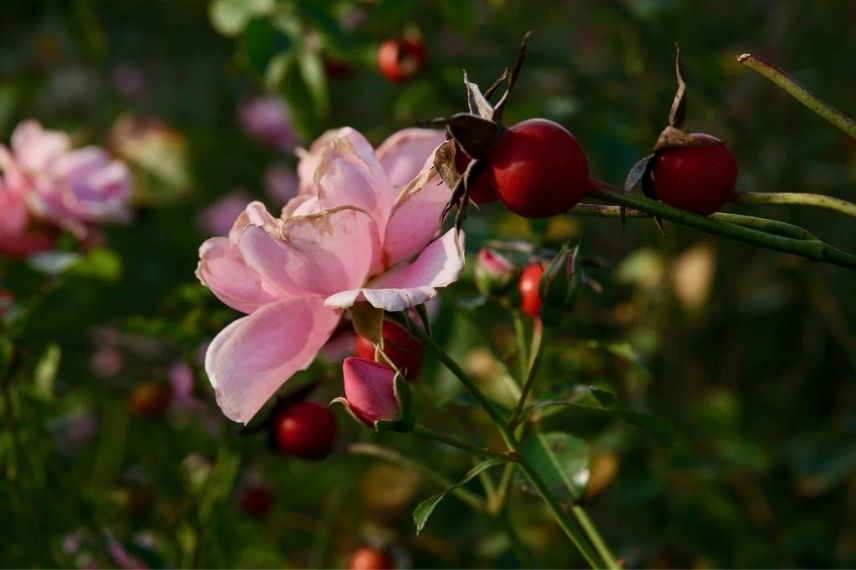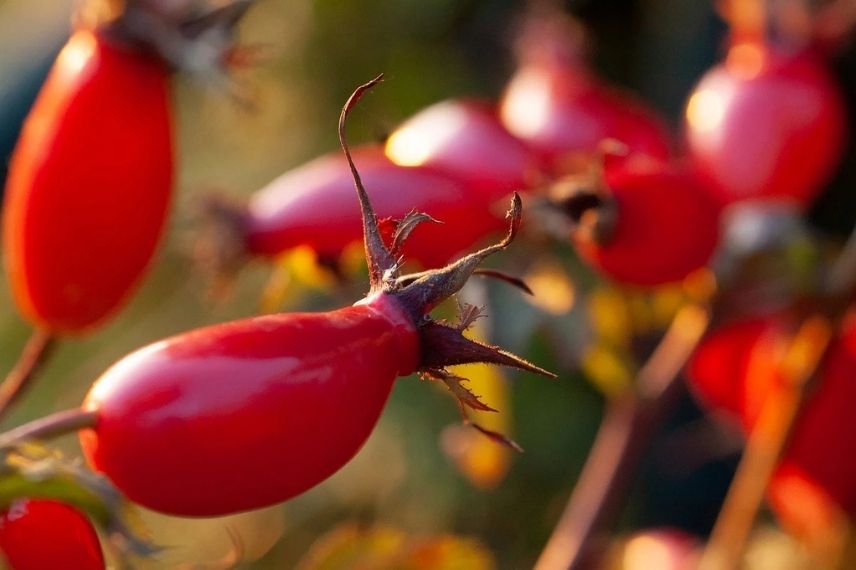Belonging to the Rosaceae family, the dog rose is a thorny shrub, with the most common species being Rosa Canina. A wild species cherished for its pretty five-petalled, heart-shaped flowers adorned with long golden stamens. Ranging from pink to white, they stand out beautifully against medium-green foliage with a bushy habit.
Appearing between May and June, its flowers gradually give way to lovely scarlet-red fruits called "hips" or "itchy-backs", due to the multitude of tiny hairs found inside. Edible and rich in vitamin C, mainly concentrated under the skin, they also contain vitamins B1 and B2, as well as potassium.
Also enjoyed as syrup or herbal tea, rose hips can be made into jam: exceptional for their vibrant red colour, they have the consistency of chestnut jam while offering a sweet and slightly tangy flavour.
In any case, they require a large quantity of fruit to yield just a few spoonfuls of this precious nectar. Discover our tutorial to learn everything from picking to preparing rose hip jam.
How to Harvest Rose Hips?
Dog Rose in the Garden
In the garden, Rosa canina is ideally planted between March and April or October and November, in neutral, deep, humus-rich, moist, well-drained soil with good sun exposure. Once established, the dog rose can grow up to 3 metres tall and 2.5 metres wide. While pruning isn’t essential, it’s advisable to remove dead wood in winter and trim older branches to encourage new growth. During flowering, between May and June, the shrub is adorned with beautiful white to pink blooms, which later give way to rose hips that can be harvested in early autumn.
Patricia’s Tip: Sometimes, I leave the fruits until the first frosts to gather rose hips with a more pronounced flavour!

Harvesting Rose Hips
As it’s a rose bush, wearing gloves is recommended to protect yourself from its sharp thorns: the hips should feel soft to the touch, with pulp that yields easily under pressure. Better yet, use secateurs and cut the branches as close to the fruit as possible to avoid tearing them. Remember, the hairs can irritate your hands.
Patricia’s Tip: For sustainable foraging, I recommend harvesting no more than 10–20% of the tree’s fruits. These berries also feed wildlife in winter. Opt for larger hips—though mostly seeds, they’ll provide more flesh for your rose hip jam.
Storing Dog Rose Fruits
Once harvested, you can either dry them or freeze them for storage. The first method is more common for herbal infusions. For the second, simply place the fruits in a freezer bag or container and thaw them at room temperature for half a day before use.

Rose Hip Jam: The Recipe
Here’s how to make perfect rose hip jam when the fruits are fully ripe. Note that if the harvested fruits are firm, cut them in half and remove the seeds and inner hairs before cooking (step 2)—this extra effort reduces the need for extensive sieving (step 3).
Step 1. Preparing the Dog Rose Fruits
After mindful harvesting, remove the stems (if using secateurs) and rinse off any dust clinging to the skin. At this stage, be sure to discard the pedicels (flower stalks) and the "fly" (black tip of the hip).
Step 2. Cooking the Rose Hips
Place the fruits in a saucepan and cover with water. Bring to a boil, then reduce heat and simmer for about 30 minutes, until the hips are tender.
Step 3. Mashing and Sieving
Next, press the hips through a potato masher to remove most seeds, skins, and hairs. If too thick, add a little cooking water. Then sieve the purée twice to eliminate stubborn irritant hairs.
Patricia’s Tip: After sieving, I strain the purée through muslin or a fine cloth to extract only the finest nectar.
Step 4. Adding Sugar and Lemon
To the prepared purée, add sugar—700g per 1kg of rose hip purée. Mix well, then stir in a little lemon juice and let it macerate overnight.
Step 5. Final Cooking
Simmer the mixture over low heat. Once boiling, stir constantly for 5–10 minutes until it reaches a thick, creamy consistency. Pour into sterilised jars, seal, and invert. Only when cooled can you enjoy it!
Patricia’s Tip: I love adding a scraped vanilla pod just before the final cook to enhance the rose hips’ natural flavour.



































Comments